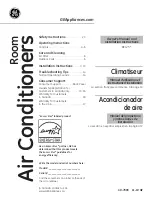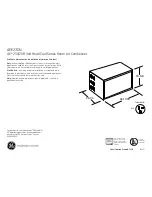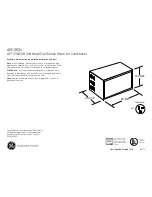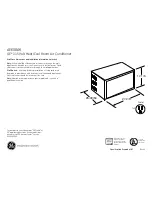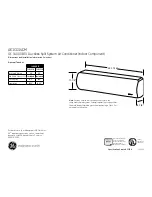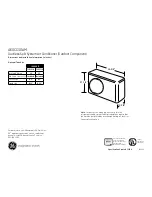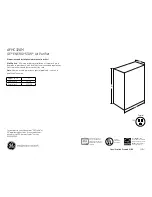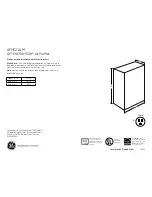
7
2-4. Presence of fi re extinguisher
• If any hot work is to be conducted on the
refrigeration equipment or any associated
parts, appropriate fi re extinguishing
equipment shall be available at hand.
• Have a dry powder or CO
2
fi re extinguisher
adjacent to the charging area.
2-5. No ignition sources
• No person carrying out work in relation to a
refrigeration system which involves exposing
any pipe work that contains or has contained
fl ammable refrigerant shall use any sources
of ignition in such a manner that it may lead
to the risk of fi re or explosion. He/She must
not be smoking when carrying out such work.
• All possible ignition sources, including
cigarette smoking, should be kept suffi ciently
far away from the site of installation,
repairing, removing and disposal, during
which fl ammable refrigerant can possibly be
released to the surrounding space.
• Prior to work taking place, the area around
the equipment is to be surveyed to make
sure that there are no fl ammable hazards or
ignition risks.
• “No Smoking” signs shall be displayed.
2-6. Ventilated area
• Ensure that the area is in the open or that it
is adequately ventilated before breaking into
the system or conducting any hot work.
• A degree of ventilation shall continue during
the period that the work is carried out.
• The ventilation should safely disperse any
released refrigerant and preferably expel it
externally into the atmosphere.
2-7. Checks to the refrigeration equipment
• Where electrical components are being
changed, they shall be fi t for the purpose
and to the correct specifi cation.
• At all times the manufacturer’s maintenance
and service guidelines shall be followed.
• If in doubt consult the manufacturer’s
technical department for assistance.
• The following checks shall be applied to
installations using fl ammable refrigerants.
- The charge size is in accordance with
the room size within which the refrigerant
containing parts are installed.
- The ventilation machinery and outlets are
operating adequately and are not obstructed.
- If an indirect refrigerating circuit is being
used, the secondary circuit shall be
checked for the presence of refrigerant.
- Marking to the equipment continues to be
visible and legible. Markings and signs that
are illegible shall be corrected.
- Refrigeration pipe or components are
installed in a position where they are unlikely
to be exposed to any substance which may
corrode refrigerant containing components,
unless the components are constructed of
materials which are inherently resistant to
being corroded or are properly protected
against being so corroded.
2-8. Checks to electrical devices
• Repair and maintenance to electrical
components shall include initial safety
checks and component inspection
procedures.
• Initial safety checks shall include but not
limit to:-
- That capacitors are discharged: this
shall be done in a safe manner to avoid
possibility of sparking.
- That there no live electrical components
and wiring are exposed while charging,
recovering or purging the system.
- That there is continuity of earth bonding.
• At all times the manufacturer’s maintenance
and service guidelines shall be followed.
• If in doubt consult the manufacturer’s
technical department for assistance.
• If a fault exists that could compromise safety,
then no electrical supply shall be connected
to the circuit until it is satisfactorily dealt with.
• If the fault cannot be corrected immediately
but it is necessary to continue operation, an
adequate temporary solution shall be used.
• The owner of the equipment must be
informed or reported so all parties are
advised thereinafter.
3. Repairs to sealed components
• During repairs to sealed components, all
electrical supplies shall be disconnected
from the equipment being worked upon prior
to any removal of sealed covers, etc.
• If it is absolutely necessary to have an
electrical supply to equipment during
servicing, then a permanently operating
form of leak detection shall be located at the
most critical point to warn of a potentially
hazardous situation.
• Particular attention shall be paid to the
following to ensure that by working on
electrical components, the casing is not
altered in such a way that the level of
protection is affected.
This shall include damage to cables,
excessive number of connections, terminals
not made to original specifi cation, damage to
seals, incorrect fi tting of glands, etc.
• Ensure that apparatus is mounted securely.
• Ensure that seals or sealing materials have
not degraded such that they no longer serve
the purpose of preventing the ingress of
fl ammable atmospheres.
• Replacement parts shall be in accordance
with the manufacturer’s specifi cations.
NOTE: The use of silicon sealant may inhibit
the effectiveness of some types of leak
detection equipment.
Intrinsically safe components do not have to
be isolated prior to working on them.
6
Prevent water leakage by ensuring drainage
pipe is:
- Connected properly,
- Kept clear of gutters and containers, or
- Not immersed in water
After a long period of use or use with any
combustible equipment, aerate the room
regularly.
After a long period of use, make sure the
installation rack does not deteriorate to
prevent the unit from falling down.
Remote control
Do not use rechargeable (Ni-Cd) batteries. It
may damage the remote control.
To prevent malfunction or damage of the
remote control:
• Remove the batteries if the unit is not going
to be used for a long period of time.
• New batteries of the same type must be
inserted following the polarity stated.
Power supply
Do not disconnect the plug by pulling the cord
to prevent electric shock.
Precaution for using R32 refrigerant
The basic installation work procedures are the same as
conventional refrigerant (R410A, R22) models.
1. Installation (Space)
• Must ensure the installation of pipe-work
shall be kept to a minimum. Avoid use
dented pipe and do not allow acute bending.
• Must ensure that pipe-work shall be
protected from physical damage.
• Must comply with national gas regulations,
state municipal rules and legislation. Notify
relevant authorities in accordance with all
applicable regulations.
• Must ensure mechanical connections be
accessible for maintenance purposes.
• In cases that require mechanical ventilation,
ventilation openings shall be kept clear of
obstruction.
• When disposal of the product, do follow
to the precautions in #12 and comply with
national regulations.
Always contact to local municipal offi ces for
proper handling.
Safety precautions
2. Servicing
2-1. Service personnel
• Any qualifi ed person who is involved with
working on or breaking into a refrigerant
circuit should hold a current valid certifi cate
from an industry-accredited assessment
authority, which authorizes their competence
to handle refrigerants safely in accordance
with an industry recognised assessment
specifi cation.
• Servicing shall only be performed
as recommended by the equipment
manufacturer.
Maintenance and repair requiring the
assistance of other skilled personnel shall
be carried out under the supervision of the
person competent in the use of fl ammable
refrigerants.
• Servicing shall be performed only as
recommended by the manufacturer.
2-2. Work
• Prior to beginning work on systems
containing fl ammable refrigerants, safety
checks are necessary to ensure that the risk
of ignition is minimised.
For repair to the refrigerating system, the
precautions in #2-2 to #2-8 must be followed
before conducting work on the system.
• Work shall be undertaken under a controlled
procedure so as to minimize the risk of a
fl ammable gas or vapour being present while
the work is being performed.
• All maintenance staff and others working
in the local area shall be instructed and
supervised on the nature of work being
carried out.
• Avoid working in confi ned spaces.
• Wear appropriate protective equipment,
including respiratory protection, as
conditions warrant.
• Ensure that the conditions within the area
have been made safe by limit of use of any
fl ammable material. Keep all sources of
ignition and hot metal surfaces away.
2-3. Checking for presence of refrigerant
• The area shall be checked with an
appropriate refrigerant detector prior to and
during work, to ensure the technician is
aware of potentially fl ammable atmospheres.
• Ensure that the leak detection equipment
being used is suitable for use with fl ammable
refrigerants, i.e. non sparking, adequately
sealed or intrinsically safe.
• In case of leakage/spillage happened,
immediately ventilate area and stay upwind
and away from spill/release.
• In case of leakage/spillage happened, do
notify persons down wind of the leaking/spill,
isolate immediate hazard area and keep
unauthorized personnel out.
( 4 / 8 )
A C I 2 P R 0 9 2 0 1












